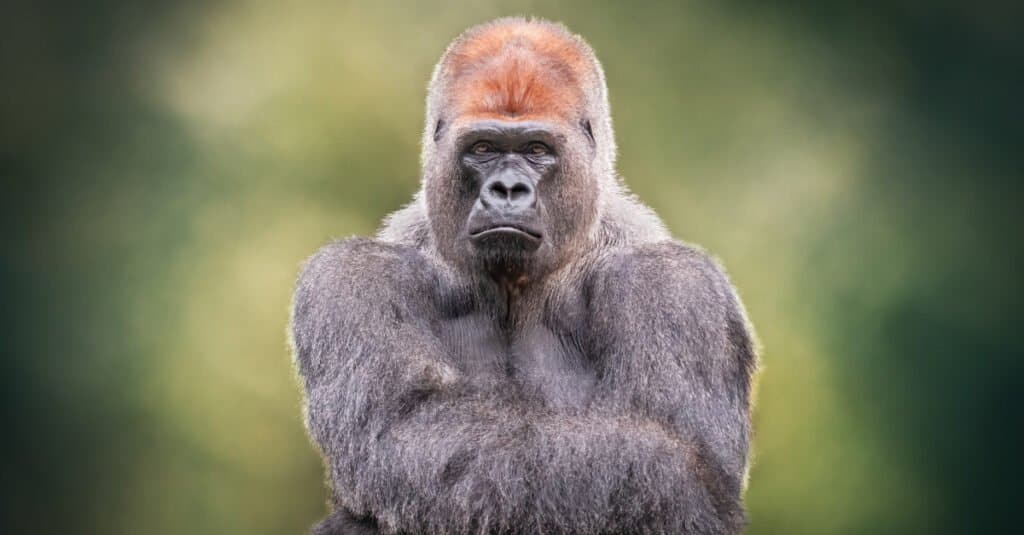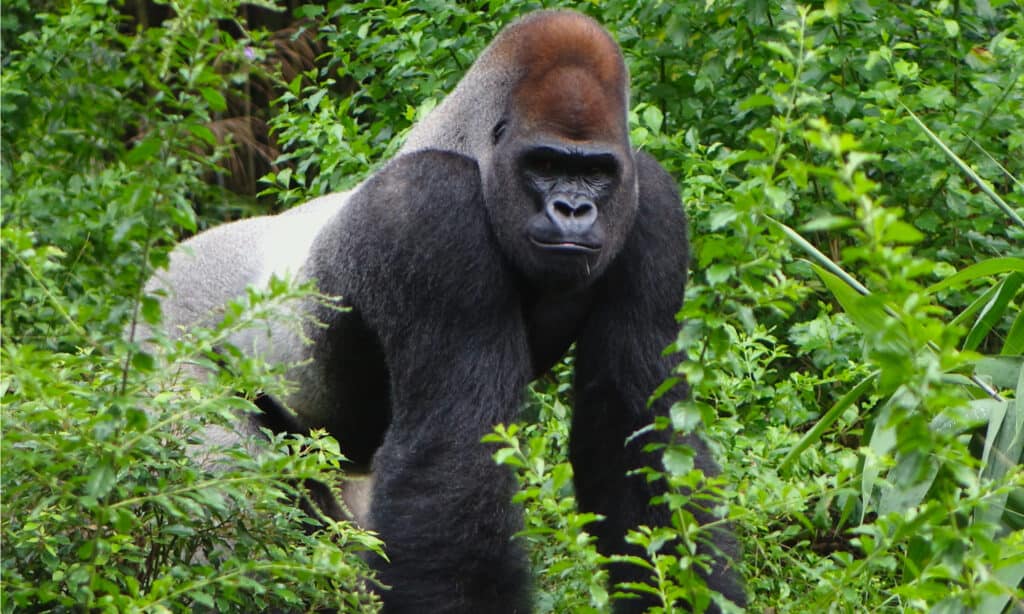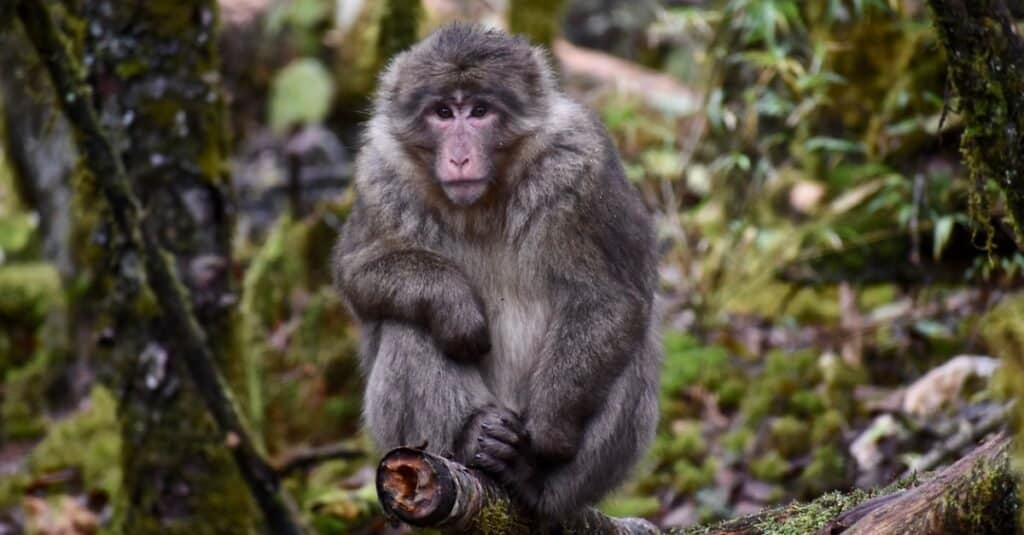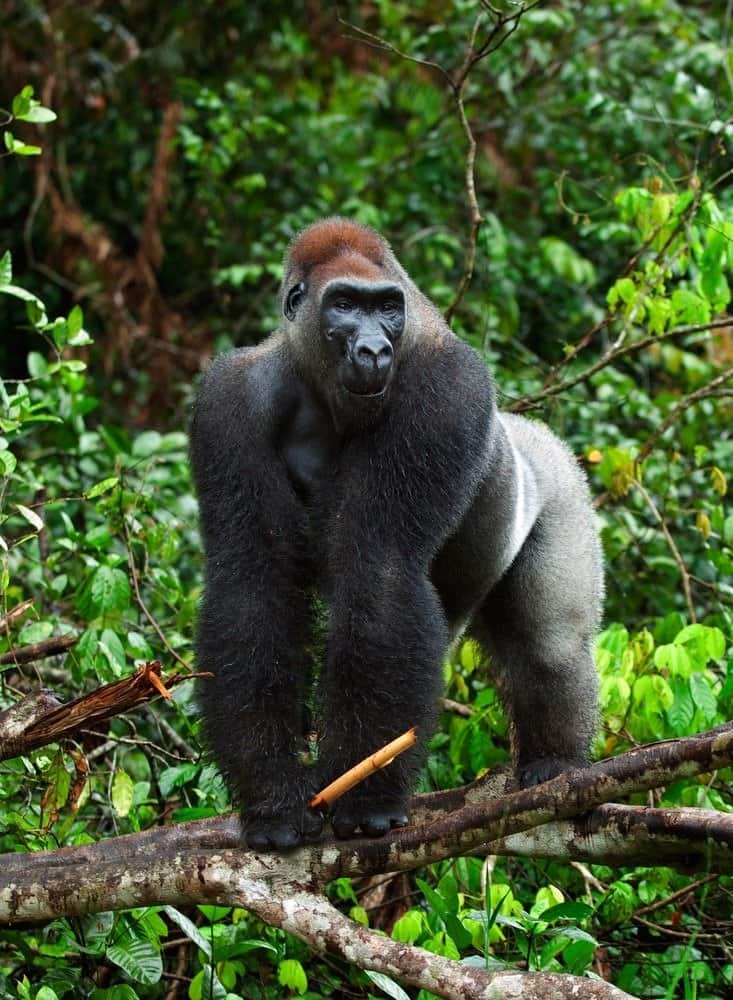When most people think of gorilla vs. monkey, they immediately think of two very different animals that share some similarities. But what are the actual variations between these two? This blog post explores seven key distinctions between gorillas and monkeys. At the end of the article, you will understand each animal much better. So, let’s get started!
Comparing Gorilla vs. Monkey

Gorillas live on the ground and are herbivorous.
©iStock.com/SooniosPro
| Gorilla | Monkey | |
|---|---|---|
| Size | Weight: 160lbs – 400lbs Height: 5ft – 6ft | (Varies greatly according to species) Weight: 3.5 ounces – 88lbs Height: 4.6 – 6.2 inches – 43.3 inches |
| Diet | Herbivorous, eat vegetation such as: Leaves Pith Stalks Roots | Primarily omnivorous, eat a variation of: Fruits Nuts Seeds Lizards Bird Eggs Insects |
| Classification | Old World | New World |
| Range | Africa: Gabon Angola Equatorial Guinea Congo Rwanda | Central and South America Africa Asia |
| Morphology | No tail Broader and more muscular Shorter limbs Larger jaw and teeth Black in color Heavier brows More prominent nostrils Flatter noses | Extreme anatomical differences between species but common characteristics are: Long tail, some are prehensile Long, slender limbs A variety of colors |
| Intelligence | Larger brains More potential for complex thought Better at problem-solving and remembering tasks | Smaller brains Are intelligent but exhibit less propensity for involved and complex tasks |
The Key Differences Between a Gorilla vs. Monkey
The key differences between gorillas and monkeys are classification within the primate order, diet, and size.
Although both gorillas and monkeys are primates, there are a few significant areas in which they differ. These key differences are classification within the primate order, diet, and size. Gorillas live mainly on the ground and are predominantly herbivorous apes that inhabit the forests of central Africa. The gorilla has two primary species and five subspecies. Also, they are the largest living primates, with their DNA similarity of 95 to 99%, depending on what defines a species.
In contrast, monkeys are a group of primates with tails and are primarily omnivorous. Most monkey species are arboreal, although some live mainly on the ground, such as baboons, which are primarily omnivorous. Monkeys range in size from the tiniest pygmy marmoset, weighing as little as 3.5 ounces, to the male mandrill, nearly 88 pounds.
There are two major monkey types, the Old World and the New World monkeys. Old World monkeys are initially from Africa and Asia, while New World monkeys are indigenous to Central and South America. The distinction is based on anatomy and refers to the different arrangements of certain bones in the hands and feet of these two groups of monkeys.
Although gorillas are apes, not monkeys, they fit into the Old World category. Other ape species include:
- Bonobos
- Chimpanzees
- Gibbons
- Orangutans
Non-ape species of primates can fall into either Old or New World categories. Some examples are:
- Macaques
- Marmosets
- Capuchins
- Spider Monkeys
- Baboons
- Langurs
- Tamarins
Gorilla vs. Monkey: Tail

Most monkeys use long tails for balance and swinging from tree to tree.
©Kjersti Joergensen/Shutterstock.com
Tails are an essential difference between gorillas and monkeys. Gorillas do not have tails, whereas most monkeys use long tails for balance and swinging from tree to tree. In some cases, the tail is prehensile, meaning it can grip or hold on to something. This ability is why you often see monkeys wrapping their tails around tree branches. Gorillas, however, have no use for tails as they live primarily on the ground. Instead, they use their strong arms to hoist themselves onto higher terrain or trees.
Gorilla vs. Monkey: Body Size and Shape

Gorillas are also taller than monkeys, with males standing around six feet tall and females about five feet tall.
©CXI/Shutterstock.com
There are many differences between gorillas and monkeys, but one of the most obvious is their size. Gorillas are much larger than monkeys, with males weighing up to 400 pounds. Monkeys, on the other hand, typically weigh less than 50 pounds. Some species of female monkeys can even weigh as little as two pounds. Gorillas are also taller than monkeys, with males standing around six feet tall and females about five feet tall. Monkeys range in size depending on the species, but they are generally much smaller than gorillas. Gorillas also have very different body shapes than monkeys. They are much broader and more muscular, with shorter limbs. Monkeys have long, slender limbs to swing from tree to tree.
Gorilla vs. Monkey: Facial Features

Monkeys can show a range of emotions on their face.
©PhotoZeli/Shutterstock.com
Though gorillas and monkeys are primates, their facial features have several key differences. For one, gorillas have much larger skulls than monkeys. This difference is because gorillas have much bigger brains than monkeys. On average, a gorilla’s brain is about three times the size of a monkey’s brain. Gorillas have much broader and more muscular than monkeys, too.
Additionally, gorillas have much heavier brows than monkeys, more prominent nostrils, and flatter noses. Finally, monkey faces are often more expressive than gorilla faces. Gorillas have a more neutral expression, while monkeys can show a range of emotions on their face.
Gorilla vs. Monkey: Movement

Gorillas use their arms to help them move around. They can knuckle-walk, where they walk on their knuckles instead of their palms.
©slowmotiongli/Shutterstock.com
Although gorillas and monkeys are both primates, they move in different ways. Gorillas are quadrupeds, meaning they walk on all fours. Monkeys are bipeds, signifying they primarily walk on two legs.
Gorillas use their arms to help them move around. They can knuckle-walk, where they walk on their knuckles instead of their palms. Monkeys’ tails help them balance and grip as they swing from branch to branch. Because gorillas are much bigger than monkeys, they can’t move as quickly or climb as high. However, gorillas are much stronger than monkeys, capable of tearing through tree branches and vegetation.
Gorilla vs. Monkey: Location

There are many species of monkeys, but most come from Central and South America, Africa, and Asia.
©Syda Productions/Shutterstock.com
When it comes to monkeys vs. gorillas, there are some critical differences in where they are in the world. For example, gorillas are indigenous only to Africa. In contrast, monkeys live all over the world in a variety of different climates.
The Western gorilla is native to Cameroon, Gabon, the Central African Republic, Angola, Equatorial Guinea, and the Congo. Eastern gorillas are native to Rwanda, Uganda, and the Democratic Republic of Congo.
There are many species of monkeys, but most come from Central and South America, Africa, and Asia.
Interestingly, only two continents in the world do not have either gorillas or monkeys – Australia and Antarctica. In addition, Europe has only one species seen in the wild; the Barbary macaque population in Gibraltar.
Gorilla vs. Monkey: Intelligence

Gorillas are much larger than monkeys, and their brains are about three times that of most monkeys.
©Sergey Uryadnikov/Shutterstock.com
There has been extensive debate over which is more intelligent, gorillas or monkeys. While both animals are incredibly smart, some key differences exist in their intelligence and communication skills.
Gorillas are much larger than monkeys, and their brains are about three times as big, depending on the monkey. This variation doesn’t necessarily mean that gorillas are three times as clever. Still, it does suggest that they have more potential for complex thought. Studies have shown that gorillas are better at problem-solving and remembering tasks than monkeys. They also have a better understanding of cause and effect.
Gorilla vs. Monkey: Communication

Monkeys use sound and body language to communicate.
©E.Matveeva/Shutterstock.com
Another difference between gorillas and monkeys is the way they communicate. Monkeys use sound and body language to communicate. At the same time, gorillas seem to have a more complex form of communication that includes specific vocalization and body cues. For example, scientists have taught gorillas and monkeys to use sign language and found that gorillas are better at using and understanding signed words than monkeys.
So, it seems that gorillas are more intelligent than monkeys. Either way, both animals are amazing creatures with complex abilities that continue to surprise us.
The photo featured at the top of this post is ©
Thank you for reading! Have some feedback for us? Contact the AZ Animals editorial team.






